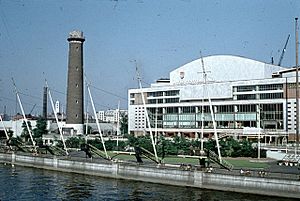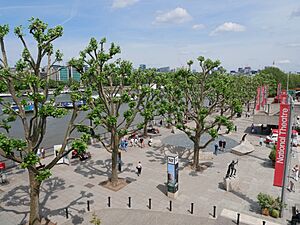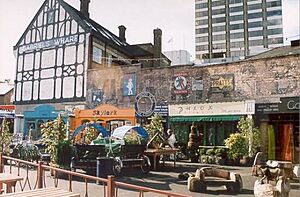South Bank facts for kids
Quick facts for kids South Bank |
|
|---|---|
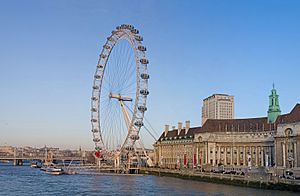 The London Eye on the South Bank at County Hall |
|
| Ceremonial county | Greater London |
| Region | |
| Country | England |
| Sovereign state | United Kingdom |
| Post town | LONDON |
| Postcode district | SE1 |
| Dialling code | 020 |
| Police | Metropolitan |
| Fire | London |
| Ambulance | London |
| EU Parliament | London |
The South Bank is a lively area in central London, England. It sits right on the south side of the River Thames, directly across from the City of Westminster. This narrow strip of land is known for its many fun places to visit and businesses. It stretches across parts of two London boroughs: Lambeth and Southwark.
While there are no exact borders, the South Bank is usually thought to be between Westminster Bridge and Blackfriars Bridge. It's about 800 meters (half a mile) southeast of Charing Cross. The name "South Bank" became popular in 1951 during a big event called the Festival of Britain.
This area is packed with famous attractions. You can find the County Hall building, the Sea Life London Aquarium, the London Dungeon, Jubilee Gardens, and the giant London Eye Ferris wheel. It's also home to the Southbank Centre, which includes the Royal Festival Hall and the National Theatre, plus BFI Southbank for movie lovers. Many of these buildings also have homes inside them.
For a long time, the South Bank was often wet and muddy in winter, which made it harder to build on than the north side of the Thames. Over its history, it has been an entertainment hub twice. In between, it was mostly used for docks, factories, and workshops. Things started to change in 1917 when County Hall was built. A famous stone lion, called the South Bank Lion, was moved there and now stands proudly near Westminster Bridge. The Queen's Walk is a special path along the river. It was built to help with drainage and to raise the land, stopping floods.
In 1951, the Festival of Britain completely changed the area. It became a major spot for arts and fun. Today, it's a very popular tourist area in central London. Many bridges connect the South Bank to the north side of the Thames, including the Golden Jubilee and Waterloo Bridge.
Contents
A Look at South Bank's Past
By the 1700s, the South Bank started to have more enjoyable places like pleasure gardens. However, its shallow riverbanks and muddy areas were also perfect for factories and docks. So, the area grew into a busy industrial zone with many different owners.
A big change happened when the London County Council needed a new main office. This building, County Hall, was built between 1917 and 1922. It was the first time a large part of the riverfront was opened up for public use. This public space grew even more in 1951 because of the Festival of Britain.
The area was officially named 'South Bank' to help promote the Festival. After the festival, some buildings were taken down to create Jubilee Gardens. But the Royal Festival Hall and The Queen's Walk stayed and became part of the Southbank Centre. Over the years, more arts and entertainment places opened along the river, like the Queen Elizabeth Hall and the Royal National Theatre.
Where is the South Bank?
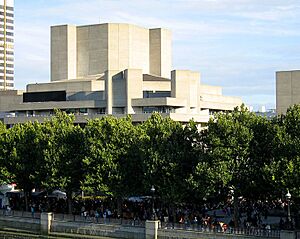
The South Bank stretches for about 5 square kilometers (two square miles) along the southern side of the River Thames. The western part of the area is in the London Borough of Lambeth. The eastern part is in the London Borough of Southwark, where it meets another area called Bankside.
There are many open public spaces along the riverside. One of these is Bernie Spain Gardens, located between the London Studios and the Oxo Tower. It's named after Bernadette Spain, a local person who worked hard to improve her community.
Arts and Fun on the South Bank
The South Bank is a very important place for arts and entertainment. The Southbank Centre is a big part of this, including the Royal Festival Hall, the Queen Elizabeth Hall, and The Hayward Gallery. Nearby, you'll find the Royal National Theatre, the London IMAX cinema, and BFI Southbank, which is great for movies.
A Polish-British artist named Feliks Topolski had a studio under one of the arches of Hungerford Bridge from 1951 until he passed away in 1989. He was asked to paint a huge mural for the Festival of Britain. His studio became a well-known spot on the South Bank. He would often have "Open Studio" Fridays where anyone could visit. Today, his studio is an archive and exhibition space, keeping his artwork and memory alive.
In 1975, Topolski got three more arches where he painted his massive 600-foot-long artwork called 'Memoir of the Century'. This painting showed his wide experiences of the 20th century. He worked on it until he died. The artwork was open to the public until 2006. After a big renovation, it reopened in 2009. However, it later became a bar called Bar Topolski, where you can still see some of his work.
The old County Hall building has been changed into The London Marriott Hotel County Hall, the Sea Life London Aquarium, and the London Dungeon.
The OXO Tower Wharf is further east along the South Bank. It has Gallery@Oxo, shops, and the OXO Tower Restaurant.
Gabriel's Wharf is an old dock area that has been updated into a shopping area. It's located at 56 Upper Ground, London, close to the Oxo Tower and Bernie Spain Gardens.
The London Studios, which used to be the home of ITV, faces the Thames. The Rambert Dance Company has its new studios nearby. The famous Old Vic and Young Vic theatres are also close by.
The Florence Nightingale Museum is also in the area. It teaches about nursing, medicine, and the Crimean War.
The space under the Queen Elizabeth Hall, called The Undercroft, has been a popular spot for skateboarders since the 1970s. It became a famous place for British skateboarding culture. Although it was once at risk of being changed, a campaign called "Long Live Southbank" helped to protect it.
The South Bank was also the main setting for the 1952 comedy film The Happy Family, which was set during the Festival of Britain.
Getting Around the South Bank
One reason the South Bank is so popular is how easy it is to get there. Many major train stations are a short walk away, including Waterloo, Charing Cross, and Blackfriars. The London Underground (Tube) also has stations on or near the South Bank. These include Westminster, Waterloo, Embankment, Blackfriars, and Southwark.
When the Thameslink Blackfriars railway station was updated, it added signs that say "for Bankside and South Bank." It's also easy to get to the north side of the river using bridges like Westminster, Golden Jubilee, Waterloo, and Blackfriars. You can also travel by boat on the river, with piers at the London Eye, Royal Festival Hall, and Bankside.
Images for kids
-
The London Eye on the South Bank at County Hall
-
The National Theatre is one of the many arts buildings on the South Bank.
-
South Bank at night, showing the lit-up National Theatre (right side), looking east towards the City of London.
See also
 In Spanish: South Bank para niños
In Spanish: South Bank para niños



